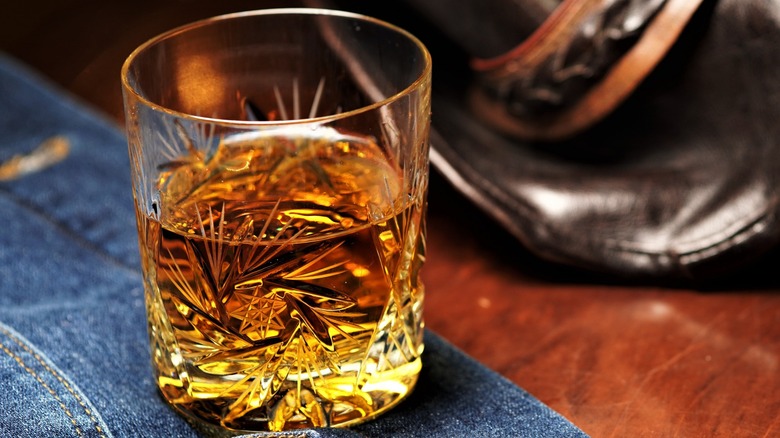What Is Straight Bourbon?
If you're just starting to explore the world of distilled liquors, you may come across some terms like "cask strength," "sour mash," or "angels' share." But if you're a bourbon enthusiast, there's one term you'll definitely encounter on a bottle label sooner or later: "straight bourbon." It's not a suggestion that the bourbon is best consumed straight without ice. Instead, it's a term used to describe a specific type of bourbon.
According to the U.S. Alcohol and Tobacco Tax and Trade Bureau (TTB), to be described as "straight bourbon whiskey," a bottle must meet certain criteria: It must be produced in the United States, have at least 51% corn in its mash bill, not have any colorings or flavorings added, not be mixed with any other kinds of spirits, not exceed 160 proof during distillation, and, finally, it must have aged for at least two years in new, charred oak barrels. The aging requirement is especially important because regular bourbon doesn't have a specific aging mandate.
This means that you can find bottles on the market that have aged for as little as three months before being sold. Consequently, when you come across a "straight bourbon" label, you can be confident that the bourbon has developed a matured taste due to proper aging. Even more so if you come across a bottle that's labeled "bottled-in-bond," which is a sub-type of straight bourbon, that has to age for at least four years before it's bottled and should have an even more pronounced and refined flavor profile.
What makes it different from other types of bourbon?
In addition to having stricter aging rules, straight bourbon has to follow some stringent purity guidelines, as well. Remember, straight bourbon can't have any extra stuff added to it or be mixed with other types of spirits. This is to set it apart from blended bourbon, which usually contains additives and is mixed with other spirits (usually un-aged grain spirits) to cut costs. This sort of whiskey can still be called bourbon as long as 51% of the bottle's content is straight bourbon.
Another unique aspect of straight bourbon is its strict adherence to blending rules. If a distillery wants to mix bourbons together and still get the label "straight bourbon," all the component liquors must be similarly straight bourbons distilled within the same state. This is because bourbon made in Kentucky, for example, can vary significantly from whiskeys made in Tennessee due to factors like climate and the water used in the bourbon distillation process.
By ensuring that all the bourbon in the blend comes from the same place and, preferably, from the same distillery, you guarantee a certain level of consistency and purity in the final product. When these conditions are not met, the product must be labeled as "blended straight bourbon whiskeys" or "a blend of straight bourbon whiskeys." While it may seem complicated, all the rules are there for just one reason: to help you tell the different sorts of bourbons apart and decide which one suits your taste and needs the best!

